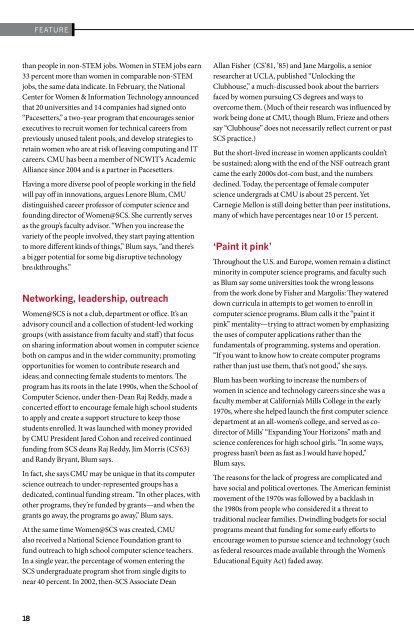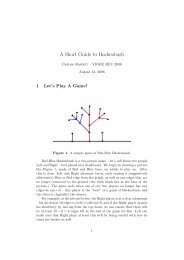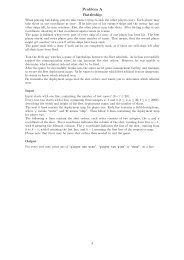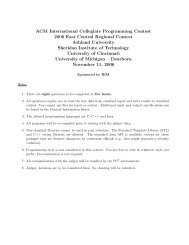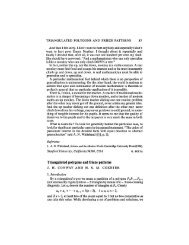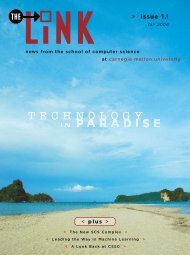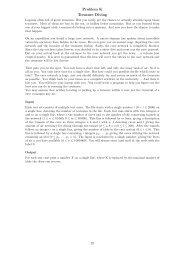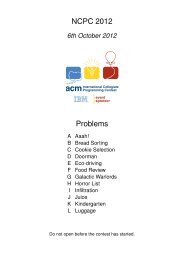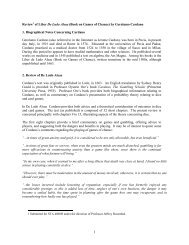Download now (1.3MB, PDF reader required) - Link home page
Download now (1.3MB, PDF reader required) - Link home page
Download now (1.3MB, PDF reader required) - Link home page
You also want an ePaper? Increase the reach of your titles
YUMPU automatically turns print PDFs into web optimized ePapers that Google loves.
FEATURE<br />
than people in non-STEM jobs. Women in STEM jobs earn<br />
33 percent more than women in comparable non-STEM<br />
jobs, the same data indicate. In February, the National<br />
Center for Women & Information Technology announced<br />
that 20 universities and 14 companies had signed onto<br />
“Pacesetters,” a two-year program that encourages senior<br />
executives to recruit women for technical careers from<br />
previously unused talent pools, and develop strategies to<br />
retain women who are at risk of leaving computing and IT<br />
careers. CMU has been a member of NCWIT’s Academic<br />
Alliance since 2004 and is a partner in Pacesetters.<br />
Having a more diverse pool of people working in the field<br />
will pay off in innovations, argues Lenore Blum, CMU<br />
distinguished career professor of computer science and<br />
founding director of Women@SCS. She currently serves<br />
as the group’s faculty advisor. “When you increase the<br />
variety of the people involved, they start paying attention<br />
to more different kinds of things,” Blum says, “and there’s<br />
a bigger potential for some big disruptive technology<br />
breakthroughs.”<br />
networking, leadership, outreach<br />
Women@SCS is not a club, department or office. It’s an<br />
advisory council and a collection of student-led working<br />
groups (with assistance from faculty and staff) that focus<br />
on sharing information about women in computer science<br />
both on campus and in the wider community; promoting<br />
opportunities for women to contribute research and<br />
ideas; and connecting female students to mentors. The<br />
program has its roots in the late 1990s, when the School of<br />
Computer Science, under then-Dean Raj Reddy, made a<br />
concerted effort to encourage female high school students<br />
to apply and create a support structure to keep those<br />
students enrolled. It was launched with money provided<br />
by CMU President Jared Cohon and received continued<br />
funding from SCS deans Raj Reddy, Jim Morris (CS’63)<br />
and Randy Bryant, Blum says.<br />
In fact, she says CMU may be unique in that its computer<br />
science outreach to under-represented groups has a<br />
dedicated, continual funding stream. “In other places, with<br />
other programs, they’re funded by grants—and when the<br />
grants go away, the programs go away,” Blum says.<br />
At the same time Women@SCS was created, CMU<br />
also received a National Science Foundation grant to<br />
fund outreach to high school computer science teachers.<br />
In a single year, the percentage of women entering the<br />
SCS undergraduate program shot from single digits to<br />
near 40 percent. In 2002, then-SCS Associate Dean<br />
Allan Fisher (CS’81, ’85) and Jane Margolis, a senior<br />
researcher at UCLA, published “Unlocking the<br />
Clubhouse,” a much-discussed book about the barriers<br />
faced by women pursuing CS degrees and ways to<br />
overcome them. (Much of their research was influenced by<br />
work being done at CMU, though Blum, Frieze and others<br />
say “Clubhouse” does not necessarily reflect current or past<br />
SCS practice.)<br />
But the short-lived increase in women applicants couldn’t<br />
be sustained; along with the end of the NSF outreach grant<br />
came the early 2000s dot-com bust, and the numbers<br />
declined. Today, the percentage of female computer<br />
science undergrads at CMU is about 25 percent. Yet<br />
Carnegie Mellon is still doing better than peer institutions,<br />
many of which have percentages near 10 or 15 percent.<br />
‘paint it pink’<br />
Throughout the U.S. and Europe, women remain a distinct<br />
minority in computer science programs, and faculty such<br />
as Blum say some universities took the wrong lessons<br />
from the work done by Fisher and Margolis: They watered<br />
down curricula in attempts to get women to enroll in<br />
computer science programs. Blum calls it the “paint it<br />
pink” mentality—trying to attract women by emphasizing<br />
the uses of computer applications rather than the<br />
fundamentals of programming, systems and operation.<br />
“If you want to k<strong>now</strong> how to create computer programs<br />
rather than just use them, that’s not good,” she says.<br />
Blum has been working to increase the numbers of<br />
women in science and technology careers since she was a<br />
faculty member at California’s Mills College in the early<br />
1970s, where she helped launch the first computer science<br />
department at an all-women’s college, and served as codirector<br />
of Mills’ “Expanding Your Horizons” math and<br />
science conferences for high school girls. “In some ways,<br />
progress hasn’t been as fast as I would have hoped,”<br />
Blum says.<br />
The reasons for the lack of progress are complicated and<br />
have social and political overtones. The American feminist<br />
movement of the 1970s was followed by a backlash in<br />
the 1980s from people who considered it a threat to<br />
traditional nuclear families. Dwindling budgets for social<br />
programs meant that funding for some early efforts to<br />
encourage women to pursue science and technology (such<br />
as federal resources made available through the Women’s<br />
Educational Equity Act) faded away.<br />
18


